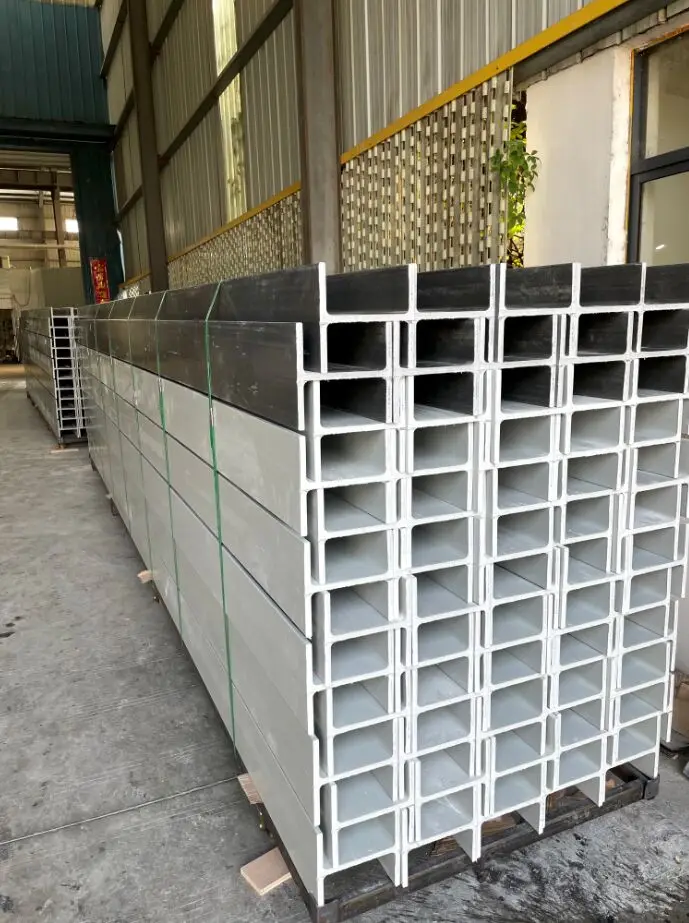- Home
- »
- Fibergrating's Blog
- »
- What are the Benefits of Fiberglass Structural Beams?
Table of Contents
The Growing Popularity of Fiberglass Beams
Fiberglass beams have gained significant traction in recent years due to their many advantages over conventional materials like steel and wood. This article delves into the benefits of incorporating fiberglass beams in construction, emphasizing their robustness, longevity, and adaptability.
Superior Strength-to-Weight Ratio of Fiberglass Beams
A key benefit of fiberglass beams is their excellent strength-to-weight ratio. Composed of glass fibers embedded in a plastic matrix, fiberglass offers remarkable strength while maintaining a low weight. This allows fiberglass beams to support substantial loads without compromising structural integrity, making them suitable for various applications, from residential to commercial construction.

Exceptional Corrosion Resistance of Fiberglass Beams
Fiberglass beams also stand out for their resistance to corrosion. Unlike steel, which can rust and deteriorate when exposed to moisture or chemicals, fiberglass remains unaffected by these elements. This characteristic makes fiberglass an ideal choice for projects where durability and longevity are critical, such as in bridges, tunnels, and other infrastructure exposed to harsh environments.
Outstanding Insulation Properties of Fiberglass Beams
Fiberglass beams excel in insulation, boasting low thermal conductivity. They do not transfer heat or cold as efficiently as materials like steel or wood, making them perfect for buildings where maintaining a stable temperature is essential, such as hospitals, schools, and office spaces.
Superior Soundproofing Capabilities
In addition to thermal insulation, fiberglass beams offer excellent soundproofing qualities. Their unique composition absorbs and dampens sound waves, making them an ideal option for noise-sensitive environments like recording studios, theaters, and conference rooms.
Versatile Size and Shape Options of Fiberglass Beams
Another notable advantage of fiberglass beams is their versatility in size and shape. Fiberglass beams can be custom-manufactured to meet specific project requirements, offering greater design flexibility than traditional materials. This enables architects and engineers to create unique and innovative structures not possible with other materials.
Environmental Benefits in Fiberglass Beams
Fiberglass beams are more environmentally friendly than steel and wood. Their production process consumes less energy and generates fewer greenhouse gas emissions compared to steel manufacturing. Additionally, fiberglass beams require no maintenance treatments like painting or sealing, which can be environmentally harmful if not properly managed.
Long-Term Cost-Effectiveness of Fiberglass Beams
Although the initial cost of fiberglass beams may be higher than that of steel or wood, their durability and minimal maintenance needs result in long-term savings. This makes them a cost-effective option for both commercial and residential construction projects.
Summary
In summary, fiberglass beams offer numerous advantages over traditional materials such as steel and wood. Their strength-to-weight ratio, corrosion resistance, insulation properties, soundproofing capabilities, versatility, environmental friendliness, and cost-effectiveness make them an ideal choice for a wide range of construction projects. As technology progresses, we can expect to see even more innovative applications for fiberglass beams in the future.

Comments
Frequently Asked Question
Fiberglass beams are made from glass fibers embedded in a plastic matrix, giving them exceptional strength while keeping their weight relatively low. This high strength-to-weight ratio allows fiberglass beams to support heavy loads without compromising structural integrity.
Fiberglass beams do not corrode when exposed to moisture or chemicals, unlike steel, which can rust and weaken over time. This corrosion resistance makes fiberglass beams ideal for projects requiring long-term durability, such as bridges, tunnels, and other infrastructure exposed to harsh environmental conditions.
Fiberglass beams have low thermal conductivity, meaning they do not conduct heat or cold as efficiently as materials like steel or wood. This property helps maintain consistent indoor temperatures, making fiberglass beams a suitable choice for energy-efficient buildings such as hospitals, schools, and offices.
Yes, the production process for fiberglass beams requires less energy and produces fewer greenhouse gas emissions than steel production. Additionally, fiberglass beams do not need maintenance treatments like painting or sealing, which can be environmentally harmful if not done correctly. This makes fiberglass beams a more sustainable choice for construction projects.
